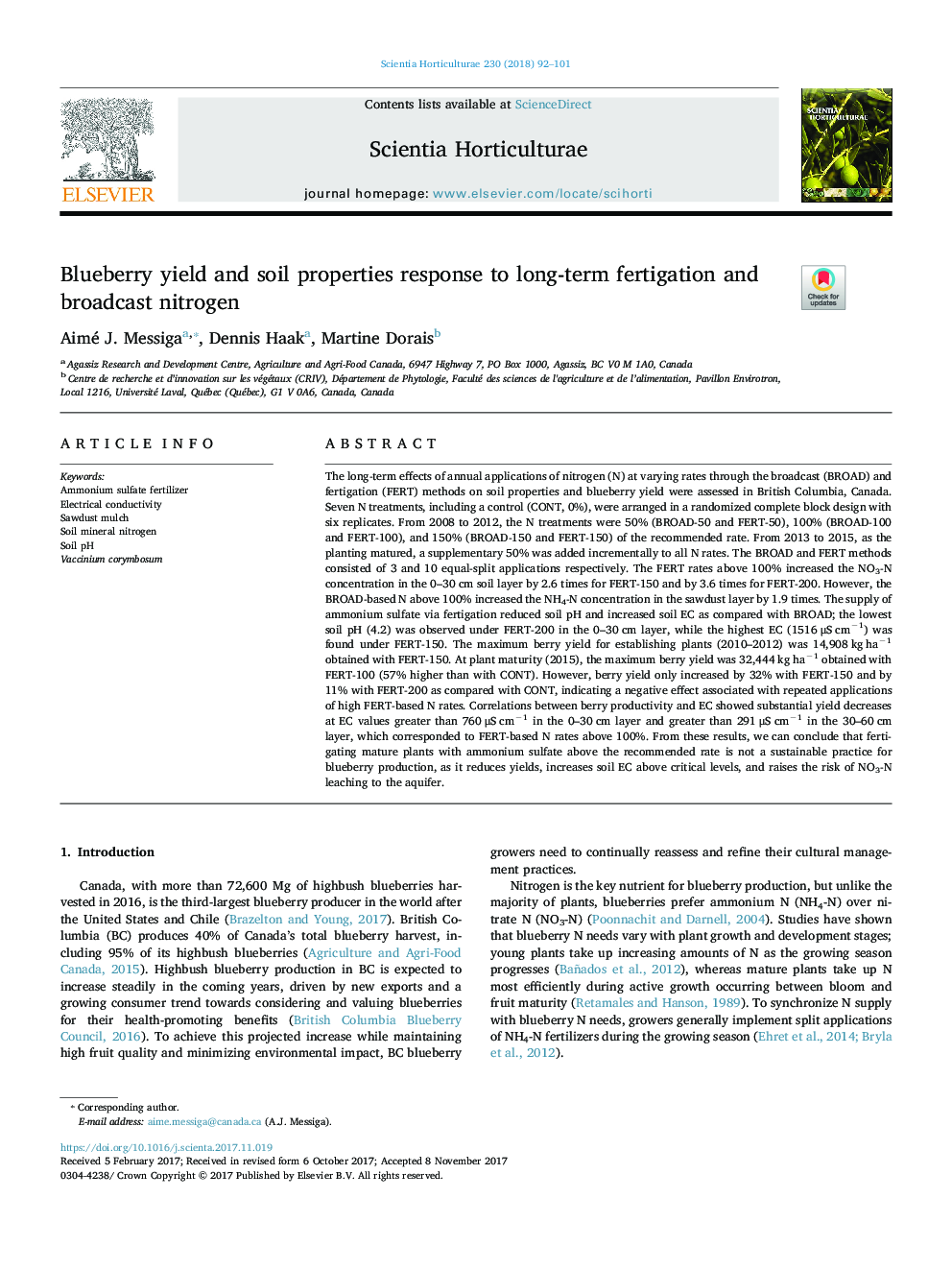| کد مقاله | کد نشریه | سال انتشار | مقاله انگلیسی | نسخه تمام متن |
|---|---|---|---|---|
| 8893036 | 1628768 | 2018 | 10 صفحه PDF | دانلود رایگان |
عنوان انگلیسی مقاله ISI
Blueberry yield and soil properties response to long-term fertigation and broadcast nitrogen
ترجمه فارسی عنوان
عملکرد زغال اخته و خواص خاک به واکنش زودهنگام و کود نیتروژن منتقل می
دانلود مقاله + سفارش ترجمه
دانلود مقاله ISI انگلیسی
رایگان برای ایرانیان
کلمات کلیدی
موضوعات مرتبط
علوم زیستی و بیوفناوری
علوم کشاورزی و بیولوژیک
دانش باغداری
چکیده انگلیسی
The long-term effects of annual applications of nitrogen (N) at varying rates through the broadcast (BROAD) and fertigation (FERT) methods on soil properties and blueberry yield were assessed in British Columbia, Canada. Seven N treatments, including a control (CONT, 0%), were arranged in a randomized complete block design with six replicates. From 2008 to 2012, the N treatments were 50% (BROAD-50 and FERT-50), 100% (BROAD-100 and FERT-100), and 150% (BROAD-150 and FERT-150) of the recommended rate. From 2013 to 2015, as the planting matured, a supplementary 50% was added incrementally to all N rates. The BROAD and FERT methods consisted of 3 and 10 equal-split applications respectively. The FERT rates above 100% increased the NO3-N concentration in the 0-30 cm soil layer by 2.6 times for FERT-150 and by 3.6 times for FERT-200. However, the BROAD-based N above 100% increased the NH4-N concentration in the sawdust layer by 1.9 times. The supply of ammonium sulfate via fertigation reduced soil pH and increased soil EC as compared with BROAD; the lowest soil pH (4.2) was observed under FERT-200 in the 0-30 cm layer, while the highest EC (1516 μS cmâ1) was found under FERT-150. The maximum berry yield for establishing plants (2010-2012) was 14,908 kg haâ1 obtained with FERT-150. At plant maturity (2015), the maximum berry yield was 32,444 kg haâ1 obtained with FERT-100 (57% higher than with CONT). However, berry yield only increased by 32% with FERT-150 and by 11% with FERTâ200 as compared with CONT, indicating a negative effect associated with repeated applications of high FERT-based N rates. Correlations between berry productivity and EC showed substantial yield decreases at EC values greater than 760 μS cmâ1 in the 0-30 cm layer and greater than 291 μS cmâ1 in the 30-60 cm layer, which corresponded to FERT-based N rates above 100%. From these results, we can conclude that fertigating mature plants with ammonium sulfate above the recommended rate is not a sustainable practice for blueberry production, as it reduces yields, increases soil EC above critical levels, and raises the risk of NO3-N leaching to the aquifer.
ناشر
Database: Elsevier - ScienceDirect (ساینس دایرکت)
Journal: Scientia Horticulturae - Volume 230, 7 January 2018, Pages 92-101
Journal: Scientia Horticulturae - Volume 230, 7 January 2018, Pages 92-101
نویسندگان
Aimé J. Messiga, Dennis Haak, Martine Dorais,
